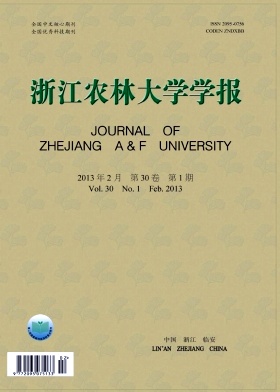| [1] |
CAO Li, WANG Weifeng, MA Xuehong, WANG Xiangfu, LI Yu, LI Li, YU Shuiqiang.
Effects of thinning on soil heterotrophic respiration of oak-pine mixed forests in Qinling Mountains
. Journal of Zhejiang A&F University,
2024, 41(1): 22-29.
doi: 10.11833/j.issn.2095-0756.20230193
|
| [2] |
LÜ Wenqiang, DONG Tianyan, BAI Fuwen.
Response of soil respiration to dry-wet alternation in karst farmland
. Journal of Zhejiang A&F University,
2024, 41(3): 1-9.
doi: 10.11833/j.issn.2095-0756.20230522
|
| [3] |
CHEN Yangen, HU Yanjing, HUANG Sha, LIU Bo, WU Jilai, WANG Yixiang.
Short-term effects of different thinning intensities on soil respiration rate in the Cunninghamia lanceolata plantation
. Journal of Zhejiang A&F University,
2023, 40(5): 1054-1062.
doi: 10.11833/j.issn.2095-0756.20220704
|
| [4] |
ZHANG Yan, ZHANG Ruixiang, LIU Zhanxin, FENG Xueqi, GUO Erhui.
Comparison of soil physical properties under different human disturbances in the Yellow River riparian zone
. Journal of Zhejiang A&F University,
2023, 40(5): 1035-1044.
doi: 10.11833/j.issn.2095-0756.20220727
|
| [5] |
FAN Yuxiang, YANG Bo, LI Yanmei, WANG Shaojun, ZHANG Lulu, ZHANG Kunfeng, XIE Lingling, XIAO Bo, WANG Zhengjun, GUO Zhipeng.
Effects of ant activities on seasonal dynamics of soil respiration in the Musa acuminata communities of Xishuangbanna
. Journal of Zhejiang A&F University,
2023, 40(3): 502-510.
doi: 10.11833/j.issn.2095-0756.20220533
|
| [6] |
BAO Jie, JIANG Feng, MA Jiawei, XU Yan, MA Yuanrui, CHEN Chuwen, YE Zhengqian, LIU Dan.
CiteSpace visualization analysis of urban green space soil research literature
. Journal of Zhejiang A&F University,
2023, 40(3): 685-694.
doi: 10.11833/j.issn.2095-0756.20210624
|
| [7] |
ZHU Wankuan, XU Yuxing, WANG Zhichao, DU Apeng.
Response of soil respiration to understory vegetation management in Eucalyptus urophylla × E. grandis plantation
. Journal of Zhejiang A&F University,
2023, 40(1): 164-175.
doi: 10.11833/j.issn.2095-0756.20220138
|
| [8] |
ZHU Wenjian, ZHANG Hui, WANG Yixiang.
Research progress on effects of cutting on forest soil respiration
. Journal of Zhejiang A&F University,
2021, 38(5): 1000-1011.
doi: 10.11833/j.issn.2095-0756.20210365
|
| [9] |
LIN Yuxuan, AI Jianguo, SONG Xinzhang, LI Quan, ZHANG Junbo.
Effects of simulated nitrogen deposition and phosphorus addition on soil respiration in Chinese fir forest
. Journal of Zhejiang A&F University,
2021, 38(3): 494-501.
doi: 10.11833/j.issn.2095-0756.20200326
|
| [10] |
HAN Mixue, YU Hongyan, LIU Panyang, RAO De’an, TENG Yue, ZOU Luyi.
Effects of the mole fraction of elevated atmospheric CO2 on soil organic carbon stability
. Journal of Zhejiang A&F University,
2021, 38(5): 963-972.
doi: 10.11833/j.issn.2095-0756.20200502
|
| [11] |
YANG Kaiye, GONG Hede, LI Jing, LIU Yuntong, SHA Liqing, SONG Qinghai, JIN Yanqiang, YANG Daxin, LI Peiguang, WEN Guojing, CHEN Aiguo, PANG Zhiqiang, ZHANG Yiping.
Dynamic characteristics of soil respiration of Savanna ecosystem in dry hot valley of Yuanjiang
. Journal of Zhejiang A&F University,
2020, 37(5): 849-859.
doi: 10.11833/j.issn.2095-0756.20190647
|
| [12] |
ZHU Wankuan, CHEN Shaoxiong, Roger ARNOLD, WANG Zhichao, XU Yuxing, DU Apeng.
Temporal and spatial dynamics of soil respiration and influencing factors in Eucalyptus plantations
. Journal of Zhejiang A&F University,
2018, 35(3): 412-421.
doi: 10.11833/j.issn.2095-0756.2018.03.004
|
| [13] |
XU Yiming, ZHANG Chao, KU Weipeng, Yilita, YU Shuquan.
Community characteristics and soil nutrients in different green space types of Zhuji City, Zhejiang
. Journal of Zhejiang A&F University,
2015, 32(4): 537-544.
doi: 10.11833/j.issn.2095-0756.2015.04.007
|
| [14] |
ZHANG Tao, LI Yongfu, JIANG Peikun, ZHOU Guomo, LIU Juan.
Research progresses in the effect of land-use change on soil carbon pools and soil respiration
. Journal of Zhejiang A&F University,
2013, 30(3): 428-437.
doi: 10.11833/j.issn.2095-0756.2013.03.021
|
| [15] |
HUANG Shi-de.
Soil respiration with precipitation and litter treatments in Schima superba and Pinus massoniana mixed forest
. Journal of Zhejiang A&F University,
2012, 29(2): 218-225.
doi: 10.11833/j.issn.2095-0756.2012.02.011
|
| [16] |
LI Hai-fang, DUAN Wen-jun.
Soil CO2 and N2O fluxes from four typical plantations in southern China
. Journal of Zhejiang A&F University,
2011, 28(1): 26-32.
doi: 10.11833/j.issn.2095-0756.2011.01.005
|
| [17] |
YE Geng-ping, LIU Juan, JIANG Pei-kun, ZHOU Guo-mo, WU Jiao-sen.
Soil respiration during the growing season with intensive management of Phyllostachys pubescens
. Journal of Zhejiang A&F University,
2011, 28(1): 18-25.
doi: 10.11833/j.issn.2095-0756.2011.01.004
|
| [18] |
TANG Jie, LI Zhi-hui, TANG Yu-xi, WU Min, LI Yong-jin, WANG Sheng.
Soil respiration dynamics for different land-use types on the shoreline of Dongting Lake
. Journal of Zhejiang A&F University,
2011, 28(3): 439-443.
doi: 10.11833/j.issn.2095-0756.2011.03.014
|
| [19] |
HAO Rui-jun, FANG Hai-lan, SHEN Lie-ying, CHE Yu-ping.
Soil organic carbon mineralization with urban plant communities in Shanghai
. Journal of Zhejiang A&F University,
2010, 27(5): 664-670.
doi: 10.11833/j.issn.2095-0756.2010.05.005
|
| [20] |
LIU Wei-hua, ZHANG Gui-lian, XU Fei, WANG Ya-ping, YU Xue-qin, WANG Kai-yun.
Soil physical and chemical properties in Shanghai’s urban forests
. Journal of Zhejiang A&F University,
2009, 26(2): 155-163.
|






 DownLoad:
DownLoad: